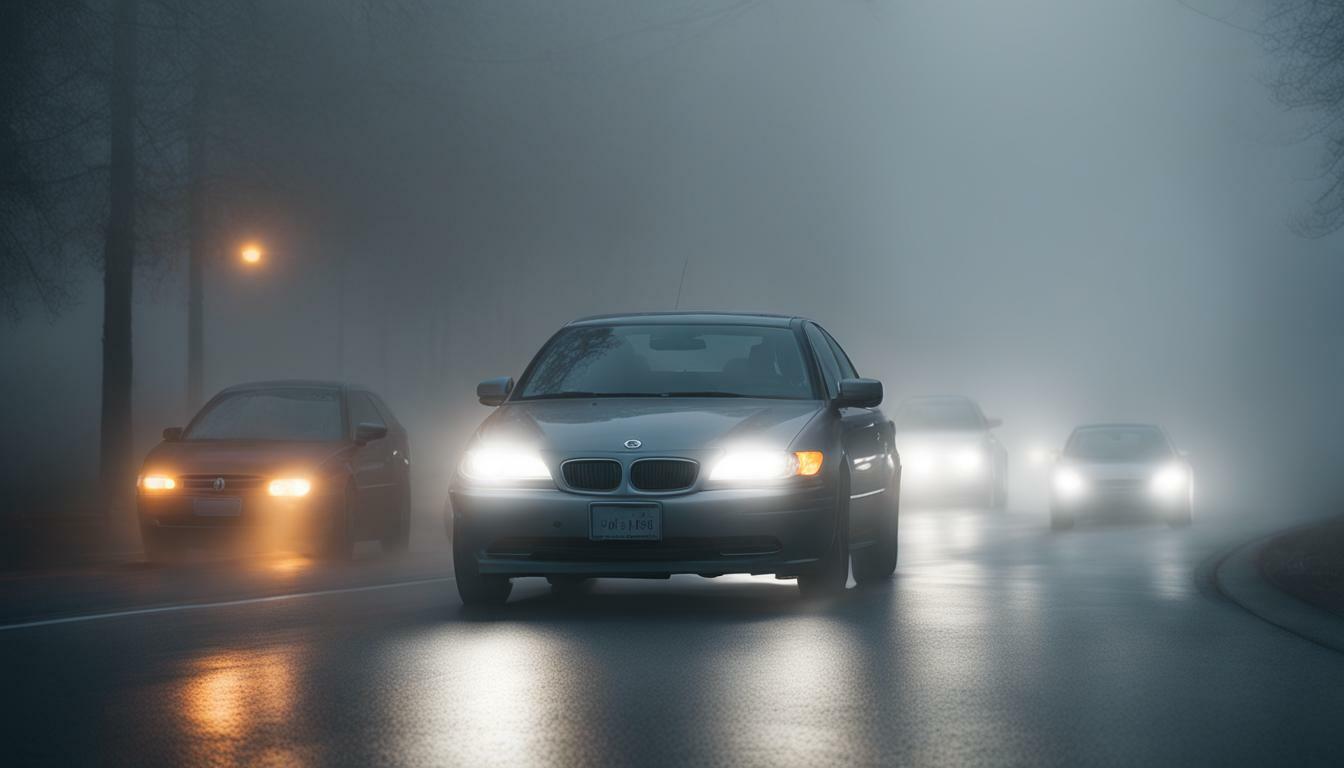Navigating through the obscurity of fog can be challenging and dangerous, but with the right driving in fog tips, you can ensure your safety on the road. Here are some key tips to keep in mind when driving in foggy conditions:
Key Takeaways:
- Slow down and allow extra time to reach your destination.
- Use low-beam headlights to make your vehicle visible without causing glare.
- Maintain a safe distance from the vehicle in front of you.
- Follow the lines on the road with your eyes to stay in the proper lane.
- In dense fog, use hazard lights and pull into a safe location.
By following these tips, you can improve your safety and reduce the risk of accidents while driving in fog.
Why Driving in Fog Requires Extra Precautions
When driving in foggy conditions, it is crucial to take extra precautions due to reduced visibility, which can significantly impact your safety on the road. Fog can obscure your view, making it difficult to see other vehicles, traffic signs, and road hazards. To ensure a safe journey, it's essential to follow these fog safety precautions:
- Slow down and allow extra time to reach your destination: Foggy conditions reduce visibility, requiring you to drive at a slower pace than usual. Give yourself ample time to react to any sudden changes on the road.
- Use your low-beam headlights to make your vehicle visible: Turn on your headlights, even during the daytime, to increase your visibility to other drivers. However, avoid using high-beam lights as they can cause glare and further impede your vision.
- Maintain a safe distance between you and the vehicle in front: Fog can make it difficult to judge distances accurately. Keep a reasonable distance from the car ahead to allow for sudden stops or maneuvers.
- Follow the lines on the road: Keep your eyes focused on the lines on the road to stay in the proper lane. This visual guide can help you navigate through the fog and avoid veering off course.
Remember, in extremely dense fog, it's best to find a safe location to pull over until conditions improve. Your safety should always be a top priority when driving in challenging weather conditions.
Emergency Situations and Pulling Over
In emergency situations or when the fog becomes too dense to navigate safely, it's crucial to take appropriate action. If you find yourself in such a situation, consider these steps:
- Turn on your hazard lights and pull into a safe location, such as a parking lot or off to the side of the road. This will alert other drivers to your presence and minimize the risk of a collision.
- Keep your headlights on at all times, but avoid using high beams in foggy conditions as they can further reduce visibility for both you and other drivers.
- If the fog becomes extremely dense, find a safe place to pull over outside of the flow of traffic. Turn off your lights to avoid confusing other drivers and wait until conditions improve before continuing your journey.
By taking these extra precautions when driving in fog, you can ensure your safety and reduce the risk of accidents. Remember to stay focused, maintain a safe speed, and be prepared to adapt your driving to the challenging conditions. Drive safely!
| Safe Driving Tips in Fog | Summary |
|---|---|
| Slow down and allow extra time | Reduced visibility requires cautious driving |
| Use low-beam headlights | Enhance visibility without causing glare |
| Maintain a safe distance | Allow for sudden stops or maneuvers |
| Follow the lines on the road | Stay in the proper lane and avoid veering off course |
Adjusting Your Driving Speed and Distance
To ensure your safety when driving in fog, it is essential to reduce your speed and maintain a safe distance from other vehicles on the road. Foggy conditions can greatly affect visibility, making it difficult to see hazards ahead or react in time. Here are some tips on how to adjust your driving speed and distance in fog:
- Slow down and allow extra time to reach your destination. By reducing your speed, you give yourself more time to react to unexpected situations that may arise in the foggy conditions.
- Maintain a safe distance between you and the vehicle in front of you. Fog can make it challenging to judge distances accurately, so it's crucial to increase your following distance to allow for better reaction time.
- Leave plenty of space between your car and the one in front of you to account for longer braking times in foggy conditions. This extra space can help prevent rear-end collisions and give you more time to stop safely.
Remember to minimize distractions and keep your full attention on the road. Avoid using cruise control and focus on maintaining complete control of your vehicle. Additionally, use the right-side line pavement marker as a guide to stay in your lane, but avoid relying solely on the center pavement lines as they may be less visible in dense fog.
By adjusting your driving speed and distance, you can reduce the risk of accidents and ensure your safety when navigating through foggy conditions. Remember to always prioritize caution and stay alert on the road!
Table: Recommended Driving Speed in Fog
| Fog Visibility | Recommended Speed |
|---|---|
| Less than 100 meters | 20 mph or less |
| 100 to 200 meters | 25-30 mph |
| 200 to 400 meters | 35-40 mph |
Proper Use of Headlights in Fog
Properly using your headlights in fog is crucial for maintaining visibility and ensuring other drivers can see your vehicle. Foggy weather driving requires specific lighting techniques to reduce the risk of accidents. When driving in fog, follow these tips to use your headlights effectively:
- Turn on your low-beam headlights to make your vehicle more visible to others. High beams should be avoided as they can cause glare and reduce visibility.
- Keep your headlights on at all times, even during the day, to enhance your car's visibility in foggy conditions.
- Utilize fog lights if your vehicle is equipped with them. These lights are specifically designed to cut through fog and improve visibility.
- Be mindful of your vehicle's taillights. Check that they are functioning properly and aren't covered in dirt or fog, as they play a crucial role in alerting other drivers from behind.
Remember, your main goal is to increase visibility and reduce the risk of collisions. By using your headlights correctly in foggy conditions, you can help ensure a safe and smooth journey.
| Key Points for Using Headlights in Fog | Benefits |
|---|---|
| Low-beam headlights | Make your vehicle more visible to others |
| Headlights on at all times | Enhance visibility during the day and in foggy conditions |
| Utilize fog lights when available | Specifically designed to cut through fog and improve visibility |
| Check taillights | Ensure they are functioning properly and visible to drivers behind you |
Lane Positioning and Road Markers in Fog
In thick fog, it becomes challenging to stay in the correct lane, but by following road markers and using visual guides, you can navigate more confidently. When visibility is limited, it's important to rely on external cues to help you maintain your lane position and stay on the right path.
Using Road Markers
Road markers, such as lane dividers and reflectors, are designed to provide guidance and enhance visibility in various weather conditions, including fog. These markers typically have reflective surfaces or are brightly colored, making them easier to spot even in low visibility. By keeping your eyes focused on these markers, you can ensure that you are staying within your lane.
| Types of Road Markers | Characteristics |
|---|---|
| Reflective Lane Dividers | These are typically white or yellow dashed or solid lines that divide lanes. They reflect light, making them visible in foggy conditions. |
| Reflective Road Studs | Raised markers with reflective surfaces that are often embedded in the pavement. They provide additional guidance by reflecting headlights. |
| Reflective Pavement Markings | These include arrows, symbols, or words painted on the road surface. They are designed to indicate specific directions or warnings and are visible even in low visibility. |
Using Visual Guides
In addition to road markers, visual guides can help you navigate through thick fog. Look for any distinguishable landmarks or objects on the side of the road, such as trees, buildings, or signs. These visual cues can serve as reference points to help you maintain your lane and stay on course.
“In thick fog, it becomes challenging to stay in the correct lane, but by following road markers and using visual guides, you can navigate more confidently.”
Remember, it's crucial to adjust your speed and maintain a safe distance from other vehicles while relying on lane positioning techniques in foggy conditions. By doing so, you can ensure your safety and reduce the risk of accidents caused by lane drifting or sudden lane changes.
Emergency Situations and Pulling Over
In case of extreme fog, it is crucial to know how to respond to emergency situations and when it's best to pull over to a safe location. When visibility is severely reduced, it can be extremely difficult to navigate the roads. If you find yourself in an emergency situation, follow these steps:
- Keep calm and avoid panic. Panicking can impair your judgment and lead to rash decisions.
- Reduce your speed gradually and avoid sudden braking or turning, as this may cause skidding or collisions.
- Activate your hazard lights to alert other drivers of your presence. This is especially important in low visibility conditions.
- Look for a safe place to pull over, such as a parking lot, rest area, or off to the side of the road. Make sure it is away from traffic and well-lit, if possible.
- Once pulled over, turn off your lights to avoid confusing other drivers. Leaving your hazard lights on can be distracting and may cause others to assume you are still on the move.
- Stay inside your vehicle with your seatbelt securely fastened. This will protect you in case another driver fails to see you parked on the side of the road.
Remember: Safety should always be your top priority in foggy conditions.
If the fog begins to dissipate and visibility improves, you can resume your journey. However, if the fog remains dense and shows no sign of clearing, it is best to wait until conditions improve. It is better to arrive late than risk your safety and the safety of others on the road.
Always remember that driving in fog requires extra caution and patience. Stay vigilant, adapt your driving speed to the conditions, and be prepared to take necessary actions to ensure your safety. By following these tips, you can navigate through foggy weather with confidence and reduce the risk of accidents.
| Emergency Situations and Pulling Over Checklist |
|---|
| Keep calm and avoid panic |
| Reduce speed gradually and avoid sudden braking or turning |
| Activate hazard lights |
| Look for a safe place to pull over |
| Turn off lights once pulled over |
| Stay inside the vehicle with seatbelt fastened |
Maintaining Visibility and Clearing Windshield
Clear visibility is essential when driving in fog, so it's vital to keep your windshield and windows clear using wipers and defrosters. The foggy conditions can cause moisture to accumulate on your windshield, obscuring your vision and making it difficult to see the road ahead. By ensuring that your windshield is clean and clear, you can greatly enhance your visibility and reduce the risk of accidents.
In addition to using your windshield wipers and defrosters, there are a few other tips you can follow to maintain visibility in fog. One effective technique is to use the right-side line pavement marker as a guide. This can help you stay in the proper lane and prevent any drift that may occur due to reduced visibility. However, it's important to avoid relying solely on the center pavement lines, as they can sometimes be difficult to see in thick fog.
Another important aspect of maintaining visibility is to use your headlights appropriately. While it's crucial to keep your headlights on at all times, it's equally important to avoid using high beams in foggy conditions. High beams can cause glare and make it even harder to see, which can be dangerous for both you and other drivers on the road. Instead, use your low-beam headlights to make your vehicle visible to others without creating excessive glare.
| Top Tips for Maintaining Visibility in Fog |
|---|
| Keep your windshield and windows clear using wipers and defrosters |
| Use the right-side line pavement marker as a guide |
| Avoid using high beams and use low-beam headlights |
| Follow other vehicles at a safe distance |
| Minimize distractions to keep your full attention on the road |
By taking these measures to maintain visibility, you can significantly improve your safety and reduce the chances of accidents while driving in foggy conditions. Remember to always adjust your driving speed and distance, stay focused on the road, and be prepared to pull over if the fog becomes too dense. With these precautions in place, you can navigate through fog safely and arrive at your destination without incident.
Conclusion
By following these driving in fog tips and taking necessary safety precautions, you can minimize risks and ensure a safer journey in foggy weather.
Driving in fog can be challenging and dangerous, but with the right approach, you can navigate through it safely. Remember to slow down and allow extra time to reach your destination. Use your low-beam headlights to make your vehicle visible to others, and avoid using high-beam lights as they can cause glare.
Maintain a safe distance between you and the vehicle in front of you, and follow the lines on the road with your eyes to stay in the proper lane. If the fog becomes extremely dense, turn on your hazard lights and pull into a safe location, such as a parking lot or off to the side of the road.
Keep your headlights on at all times, but avoid using high beams in foggy conditions. Minimize distractions and keep your full attention on the road. Use the right-side line pavement marker as a guide, but avoid using the center pavement lines. Keep your windshield and windows clear by using windshield wipers and defrosters.
Remember to leave plenty of space between your car and the one in front of you to account for longer braking times in foggy conditions. Avoid using cruise control to maintain complete control of your vehicle. And if the fog is particularly bad, consider staying home if possible.
If you choose to pull over and wait out the fog, pull as far to the side of the road as possible and turn on your hazard lights to let other drivers know your location. By following these tips, you can improve your safety and reduce the risk of accidents while driving in fog.
FAQ
Why is it important to drive cautiously in foggy conditions?
Driving cautiously in foggy conditions is important because reduced visibility can make it difficult to see other vehicles, objects, or road hazards. By driving cautiously, you can increase your reaction time and reduce the risk of accidents.
Should I use high-beam headlights in fog?
No, it is recommended to use low-beam headlights in fog. High-beam lights can cause glare and reduce visibility even further. Low-beam headlights help make your vehicle visible to others without causing excessive glare.
How should I adjust my driving speed and distance in fog?
It is important to reduce your speed and maintain a safe distance between your vehicle and the one in front of you. Fog can make it harder to judge distances and react to sudden changes in traffic, so maintaining a safe distance allows for better reaction time.
How can I stay in the proper lane when driving in thick fog?
To stay in the proper lane when driving in thick fog, follow the lines on the road with your eyes. Use the right-side line pavement marker as a guide, but avoid using the center pavement lines as they can lead you into oncoming traffic.
What should I do in emergency situations or when the fog becomes too dense?
In emergency situations or when the fog becomes too dense, it is important to pull over to a safe location, such as a parking lot or off to the side of the road. Turn on your hazard lights to let other drivers know your location. If the fog is extremely dense, find a safe place to pull over outside of the flow of traffic and turn off your lights.
How can I maintain visibility and clear my windshield in foggy conditions?
To maintain visibility in foggy conditions, use windshield wipers and defrosters to keep your windshield and windows clear. This will help you see the road and other vehicles more clearly.
What is the importance of following driving in fog tips?
Following driving in fog tips is crucial for your safety and the safety of others on the road. These tips help you navigate through foggy conditions with reduced visibility and reduce the risk of accidents.



